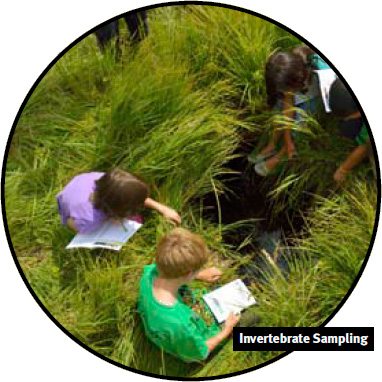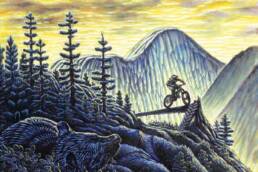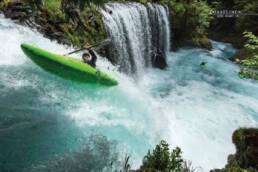With elusive funding and mountains of data required for hypothesis, who can afford the science needed to solve our world’s problems? Maybe you. Born from the days of Newton and Darwin, the Citizen Science movement could make stewards, and perhaps saviours, of us all.
[one_third]
“is this deep enough?” Paige asks. Within an inch of swamping her rubber boots, my 10-year-old daughter is standing in the Strait of Georgia, near Comox, British Columbia, with an old 500-millilitre pop bottle in one hand and a look of “I’m-only-herecause- you-made-me” on her face. “Don’t go any farther,” I say, imagining the reaction to her favourite pants getting soaked.
She stops and dunks the bottle. “Oh, it’s cold,” she moans grumpily, filling the clear plastic with ocean water, some seaweed floaties and likely a bunch of microscopic plastic. Sloshing back to shore she pouts, “Now what?”
I screw on the cap and take notes about the location and sea and weather conditions, while Paige crosses her arms. Later we’ll send the sample and observations to Adventurers and Scientists for Conservation (ASC), a charity that helps link scientists in need of data and citizens willing to get it for them.
[/one_third]
[one_third]
Known as “citizen science,” the idea has been around for many years. This particular project my daughter and I are involved in is one of a growing number engaging citizens like Joe Bunsen to sift through piles of data, collect samples, service cameras and watch videos, all in the name of helping professional scientists make important discoveries. Before the 19th century, many scientific discoveries were made by “gentleman scientists” with day jobs: Sir Isaac Newton, Benjamin Franklin and Charles Darwin made discoveries outside their vocation. Lewis and Clark gathered info on everything from plants and animals to First Nations culture. Astronomy in particular is full of amateurs. The volunteer annual Audubon Christmas Bird Count is in its 115th year, but in recent years has taken off thanks to ubiquitous access to smartphones and the Internet. The snowball effect has scientists in just about every field seeing the potential and the payoff.
[/one_third]
[one_third_last]
“Today science is more and more about big amounts of data,” says Jordan Holsinger, the ASC’s scientific manager. “One or two people in a lab don’t have time to sift through all the information to do science on that scale. Citizen science is crowdsourced scientific analysis.” What the scientists get out of the deal is obvious: plenty of data and knowledge without the time or expense of gathering it themselves. But for the citizens it’s a little more subtle.
Paige and I are taking part in a marine microplastics study. ASC will analyze our Comox water sample for microscopic bits of plastic bags, bottles and other refuse.
“I don’t see any plastic in here,” Paige says holding the bottle up and peering in.
“You know about erosion, right?” I ask and she nods. “Well, plastic can erode too. It breaks down into tiny bits we can’t see, but they never disappear.” Surprisingly her tween eyes aren’t glossing over.
[/one_third_last]
The idea of citizen science has been around for hundreds of years. Before the 19th century, many scientific discoveries were made by “gentleman scientists” with day jobs: sir isaac newton, benjamin franklin and charles darwin made discoveries outside their vocation.
We have a great talk about how small microplastics are. About how all those bits of trash end up in the ocean in the first place. About how some exfoliants and even toothpaste have tiny bits of plastic in them and that when flushed down the drain end up in the ocean. “Eww,” says Paige. “Why would you want to brush with plastic?” The questions continue.
asc’s microplastics study is a great example of crowd power. Bottles of ocean water are being sent from all over the world, a scale no individual science lab could ever manage. So far 90 per cent of samples, from all the world’s oceans, contain microplastics. Holsinger believes tiny organisms at the bottom of the food chain ingest the plastics. Bigger organisms eat them and so on, progressively accumulating trash at each step up the cycle. The effects are unknown. The ASC is using the study’s results to help push through legislation banning microplastics in products like facial scrubs and toothpaste.
This is just one of the ASC’s projects. Over the last two winters, the ASC partnered with Olympic National Park in Washington State to help search for an elusive rainforest creature — the pine marten. The park’s population was thought to be three, but no one had seen one in years. The ASC helped find volunteers to bushwhack through the rainforest to service and collect images from remote wildlife cameras every two weeks, all winter long. The shy pine marten remains unseen, but plenty of other wildlife information was gathered.
The ASC also tas ked summer hikers with collecting slime from lakes and rivers in the Cascades and other western mountain ranges so they could search for new species of diatoms, a simple organism that holds clues to how the climate is changing. Fifteen new species were discovered during the project and one of the most prolific samplers, Seattle resident Craig Weiland, had one named after him: Encyonopsis weilandii. “I would say [the diatom project] has actually added to my adventures more than anything,” he says. “I was going to many of these places already, and now I can get something else out of them. It almost seems like I wasted a lot of opportunities on previous trips in which I didn’t take samples.”
ked summer hikers with collecting slime from lakes and rivers in the Cascades and other western mountain ranges so they could search for new species of diatoms, a simple organism that holds clues to how the climate is changing. Fifteen new species were discovered during the project and one of the most prolific samplers, Seattle resident Craig Weiland, had one named after him: Encyonopsis weilandii. “I would say [the diatom project] has actually added to my adventures more than anything,” he says. “I was going to many of these places already, and now I can get something else out of them. It almost seems like I wasted a lot of opportunities on previous trips in which I didn’t take samples.”
That’s one of the neat things about citizen science, says Chandra Clarke, the author of the book Be the Change: Saving the World With Citizen Science and a frequent citizen scientist herself. Potentially more important than any piece of data collected is what being involved does to the citizens. “A lot of problems are big, and for the individual person it’s easy to feel overwhelmed and not know how they can contribute,” she says. “Citizen science makes it easy to get involved in a meaningful way without having to have a PhD. Whenever someone takes part in one of these programs they increase their understanding and interest in science. That’s really important in so many different ways.”
Not all citizen-science projects are as adventurous; many can be done from the comfort of home. Chandra Clarke and her kids sifted through dirt from an archeology site looking for missed pieces of bone. Others task people with analyzing images from the Hubble space telescope. There are plenty of opportunities to play video games in the name of science, too.
Ocean Network Canada, a multi-discipline ocean-monitoring lab at the University of Victoria, has laid 180 instruments and 3,400 sensors along the British Columbia coast that gather information on everything from water chemistry to fish abundance. Since the monitoring began in 2006, 250 terabytes of video footage (and counting) has been collected. “Video is one of the only ways to study the deep sea,” says Maia Hoeberechts, the associate director of user engagement at ONC. “The problem is extracting the information we want from all that video.”
ONC developed a series of citizen-science games and tools to engage all kinds of people — 10 year olds to retirees from all over the world — in parsing out the information their scientists are looking for. Most involve watching video and reporting marine life, so researchers can later focus on the most interesting clips. “There’s lots of cool stuff to see,” gushes 11-year-old Nolin Walsh, while telling about the time a crab filled the screen and the smorgasbord of marine life scurrying around a thermal vent. “It’s neat to imagine that scientists are looking at this video and finding something important because of me.”
 Many citizen science projects like this seem like a job for a computer, but science is often about subtleties. “It’s very hard to teach a computer to count sable fish, but a 10-year-old can do it almost without training,” says Hoeberechts. “Human eyes are so much more adept and flexible. Crowdsourcing harnesses the visual powers of many eyes. Everyone brings something different to the table and that’s very valuable in science.”
Many citizen science projects like this seem like a job for a computer, but science is often about subtleties. “It’s very hard to teach a computer to count sable fish, but a 10-year-old can do it almost without training,” says Hoeberechts. “Human eyes are so much more adept and flexible. Crowdsourcing harnesses the visual powers of many eyes. Everyone brings something different to the table and that’s very valuable in science.”
But perhaps more important is engaging people in the world around them. By contributing to something bigger, we invariably care a little more about what happens outside ourselves, about fish in the sea, pine martens in the mountains and plastics in our oceans.
Back in Comox, Paige stops to catch a few crabs scurrying under the rocks. “Do you think the plastic makes them sick?” she asks. I don’t have an answer for that one, and I’m not sure either of us really want to know the truth. But I’m excited to see collecting a bottle of water has switched on something in her young brain. We head back down the beach towards home. A piece of plastic flutters in the wind, and before
I can stoop to pick it up, Paige grabs it and stuffs it in my pocket.
“We don’t want that getting in the water,” she says.
Ryan Stuart
Ryan Stuart has been fascinated by the natural world since he was a kid, and he’s now sharing this interest through his freelance writing, which he does from Comox on Vancouver Island, British Columbia.
Related Stories
KMC Editor’s Intro: Science is Art is Science
In his editor’s introduction of the March 2015 issue of Canada’s The Walrus magazine, John MacFarlane bids readers…
The Science of Sport 2: Mystery Machine
[divider] A collection of essays from Coast Mountain Culture’s writers that explores how science supports our bodies as…
CMC Editor’s Intro: Wrong You Are
Most people know the Big Bang created our universe. Unless one believes humankind to be the work of Zeus, Buddha, a…
Surfing Vancouver
For Vancouver surfers, finding waves usually means a flight, a ferry or a dash south to Washington. But every so often…






